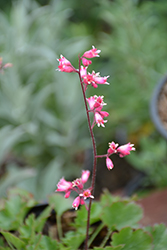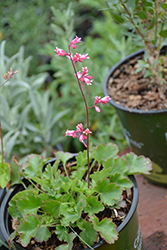Fri & Sat 8am - 8pm
Sun 8am - 7pm
Anytown, USA 12345
fax: 261.787.0463
e-mail: info@successgc.com


Plant Finder

Jack O' the Rocks
Heuchera rubescens var. glandulosa
Plant Height: 5 inches
Flower Height: 20 inches
Spacing: 12 inches
Sunlight:
![]()
![]()
Hardiness Zone: 6a
Other Names: Pink Coralbells, Pink Coral Bells, Alumroot
Description:
A very attractive and unusual variety featuring small, lightly ruffled, grape-like dark green leaves with fine red edges; spikes of pink and white blooms appear mid spring to fall; has great versatility; keep soil moist in heat of summer
Ornamental Features
Jack O' the Rocks features dainty spikes of pink bell-shaped flowers with white tips rising above the foliage from mid spring to late summer. Its attractive small crinkled lobed leaves remain dark green in color with distinctive red edges throughout the year. The dark red stems can be quite attractive.
Landscape Attributes
Jack O' the Rocks is a dense herbaceous evergreen perennial with tall flower stalks held atop a low mound of foliage. Its relatively fine texture sets it apart from other garden plants with less refined foliage.
This is a relatively low maintenance plant, and is best cleaned up in early spring before it resumes active growth for the season. It is a good choice for attracting bees, butterflies and hummingbirds to your yard, but is not particularly attractive to deer who tend to leave it alone in favor of tastier treats. It has no significant negative characteristics.
Jack O' the Rocks is recommended for the following landscape applications;
- Mass Planting
- Rock/Alpine Gardens
- Border Edging
- General Garden Use
- Groundcover
- Container Planting
Planting & Growing
Jack O' the Rocks will grow to be only 5 inches tall at maturity extending to 20 inches tall with the flowers, with a spread of 14 inches. When grown in masses or used as a bedding plant, individual plants should be spaced approximately 12 inches apart. Its foliage tends to remain low and dense right to the ground. It grows at a medium rate, and under ideal conditions can be expected to live for approximately 10 years. As an evegreen perennial, this plant will typically keep its form and foliage year-round.
This plant does best in partial shade to shade. It prefers to grow in average to moist conditions, and shouldn't be allowed to dry out. This plant does not require much in the way of fertilizing once established. It is not particular as to soil pH, but grows best in sandy soils. It is somewhat tolerant of urban pollution. Consider covering it with a thick layer of mulch in winter to protect it in exposed locations or colder microclimates. This species is native to parts of North America. It can be propagated by division.
Jack O' the Rocks is a fine choice for the garden, but it is also a good selection for planting in outdoor pots and containers. With its upright habit of growth, it is best suited for use as a 'thriller' in the 'spiller-thriller-filler' container combination; plant it near the center of the pot, surrounded by smaller plants and those that spill over the edges. Note that when growing plants in outdoor containers and baskets, they may require more frequent waterings than they would in the yard or garden.

